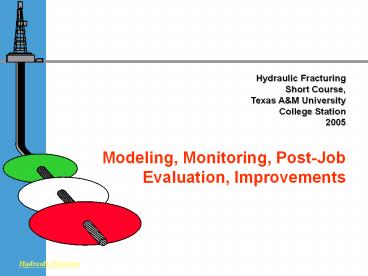HFSC - PowerPoint PPT Presentation
1 / 56
Title:
HFSC
Description:
Tiltmeter techniques. Spinner survey. Fracture. Modeling 35. Sc ... Tiltmeter Results. after Economides at al. Petroleum Well Construction. Fracture. Modeling ... – PowerPoint PPT presentation
Number of Views:482
Avg rating:3.0/5.0
Title: HFSC
1
Hydraulic Fracturing Short Course, Texas AM
University College Station 2005 Modeling,
Monitoring, Post-Job Evaluation, Improvements
2
3D
3
P3D and 3D Models
- FracPro (RES, Pinnacle Technologies)
- FracCADE (Dowell)
- Stimwin (Halliburton) and PredK (Stim-Lab)
- TerraFrac
- StimPlan
- MFrac
4
Dimensionless Form of Nordgren Model
tD(xfD) inverse of xfD(tD)
xD 0 (wellbore)
xD xfD (tip)
5
Propagation Criterion of the Nordgren Model
- Net pressure zero at tip
- Once the fluid reaches the location, it opens
up immediately - Propagation rate is determined by how fast the
fluid can flow
6
Other Propagation Criteria
- (Apparent) Fracture Toughness
- Dilatancy
- Statistical Fracture mechanics
- Continuum Damage mechanics
7
Fracture Toughness Criterion
Stress Intensity Factor KI pnxf1/2
8
CDM
What is the time needed for D to start at D 0
and grow to D 1 ?
9
CDM Propagation Criterion
Combined Kachanov parameter
10
P3D
- Pseudo 3 D Models Extension of Nordgrens
differential model with height growth - Height criterion
- Equilibrium height theory
- or Assymptotic approach to equilibrium
- Plus some tip effect
11
3D (Finite Element Modeling)
12
Fracture Toughness Criterion
Fluid flow in 2 D Fluid loss according to local
opening time Propagation Jumps Stress Intensity
Factor KI gt KIC ?
13
Data Need for both P3D and 3D
- Layer data
- Permeability, porosity, pressure
- Youngs modulus, Poisson ratio, Fracture
toughness - Minimum stress
- Fluid data
- Proppant data
- Leakoff calculated from fluid and layer data
14
Design Tuning Steps
- Step Rate test
- Minifrac (Datafrac, Calibration Test)
- Run design with obtained ?min (if needed) and
leakoff coefficient - Adjust pad
- Adjust proppant schedule
15
Step rate test
Bottomhole pressure
Injection rate
Time
16
Step rate test
17
Fall-off (minifrac)
3 ISIP 4 Closure 5 Reopening 6 Forced closure 7
Pseudo steady state 8 Rebound
1
5
2
3
4
8
Injection rate
Bottomhole pressure
Injection rate
2nD injection cycle
1st injection cycle
7
shut-in
flow-back
Time
18
Pressure fall-off analysis(Nolte)
19
g-function
dimensionless shut-in time
area-growth exponent
where Fa, b c z is the Hypergeometric
function, available in the form of tables and
computing algorithms
20
g-function
21
Pressure fall-off
Fracture stiffness
22
Fracture Stiffness(reciprocal compliance)
Pa/m
23
Shlyapobersky assumption
- No spurt-loss
bN
mN
Ae from intercept
pw
g0
24
Nolte-Shlyapobersky
25
1 g-function plot of pressure 2 get parameters
bN and mN
3 Calculate Rf (fracture extent -radius)
4 Calculate CLAPP (apparent leakoff coeff)
5 Calculate wL (leakoff width)
6 Calculate we (end-of pumping width)
7 Calculate h (fluid efficiency)
26
Computer Exercise 3-1 Minifrac analysis
27
Example
- Permeable (leakoff) thickness, ft, 42
- Plane strain modulus, E' (psi), 2.0E6
- Closure Pressure, psi, 5850
28
Output
29
From "apparent" to "real (radial)
30
Redesign
- Run the design with new leakoff coefficient
- (That is why we do minifrac analysis)
31
Monitoring
- Calculate proppant concentration at bottom
(shift) - Calculate bottomhole injection pressure, net
pressure - Calculate proppant in formation, proppant in well
- Later Add and synchronize gauge pressure
32
Nolte-Smith plot
Wellbore screenout
Log net pressure
Tip screenout
Normal frac propagation
Unconfined height growth
Log injection time
33
Post-Job Logging
- Tracer Log
- Temperature Log
- Production Log
34
Available Techniques for Width and Height
- Measured Directly
- Formation Micro Scanner
- Borehole Televiewer
- Based on Inference
- Temperature Logging
- Isotopes (fluid, proppant)
- Seismic Methods, Noise Logging
- Tiltmeter techniques
- Spinner survey
Radius of penetration
35
ScSb IrTracerlog
36
Tiltmeter Results
after Economides at al. Petroleum Well
Construction
37
Pressure Match with 3D Simulation
38
3D Simulation
Texaco EP
FracCADE
OCS-G 10752 D-12
Actual
05-23-1997
Flow Capacity Profiles
Propped Width (ACL)
Conductivity - Kfw
Mark of Schlumberger
39
Well Testing The quest for flow regimes
40
Design Improvement in a Field Program
- Sizing
- Pad volume for generic design
- More aggressive or defensive proppant schedule
- Proppant change (resin coated, high strength
etc.) - Fluid system modification (crosslinked, foam)
- Proppant carrying capacity
- Leakoff
- Perforation strategy changes
- Forced closure, Resin coating, Fiber
reinforcement, Deformable particle
41
Example Tortuous Flow Path
- Analysis of the injection rate dependent element
of the treating pressure - Does proppant slug help?
- Does limited entry help?
- Does oriented perforation help?
- Extreme reconsidering well orientation
- e.g. S shaped
42
Misalignment
43
Fracture Orientation Perforation Strategy after
Dees J M, SPE 30342
From overbalanced perforation
From underbalanced perforation
44
High Viscosity slugs
45
Proppant Slugs
46
Case Study Effect of Non-Darcy Flow
- Forcheimer Equation
- Cornell Katz
47
Non-Darcy Flow
- Dimensionless Proppant Number is the most
important parameter in UFD
Effective Proppant Pack Permeability
48
Non-Darcy Flow
- Effective Permeability
keff is determined through an iterative
process Drawdown is needed to calculate velocity
- Reynolds Number
49
Non-Darcy Flow Coefficient (b)
- Several equations have been developed mostly from
lab measurements (empirical equations) - General form of b equation
- where b is 1/m and k is md
50
(No Transcript)
51
Case Study Reynolds number
52
Case Study Proppant number
53
Case Study Max possible JD
54
Case Study Optimum frac length
55
Case Study Optimum frac width
56
Summary
- Increasing role of evaluation
- Integration of reservoir engineering, production
engineering and treatment information - Cost matters
- Expensive 3D model does not substitute thinking
- Still what we want to do is increasing JD


















